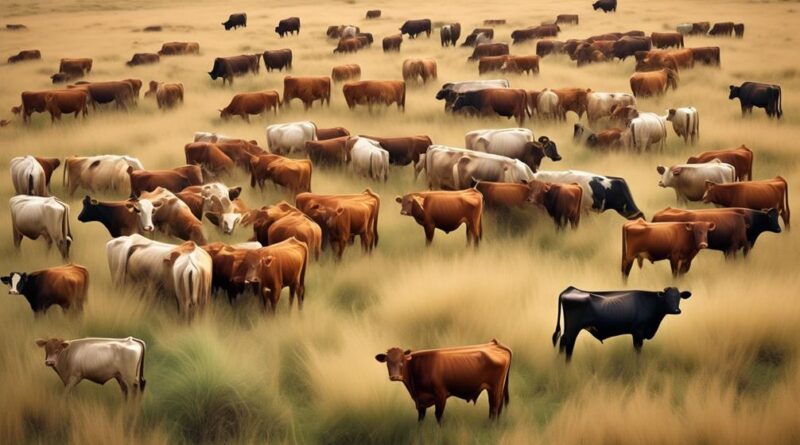Enhancing Cattle Foraging With Native Grass Species
Did you know that incorporating native grass species into cattle foraging systems has been shown to increase forage production by up to 40% in some cases?
The utilization of native grasses presents an opportunity to significantly improve the efficiency and sustainability of cattle grazing operations.
By exploring the benefits of native grass species, identifying the ideal options for cattle foraging, and understanding the nutritional and economic implications, you can gain valuable insights into how to enhance your cattle foraging practices.
Benefits of Native Grass Species
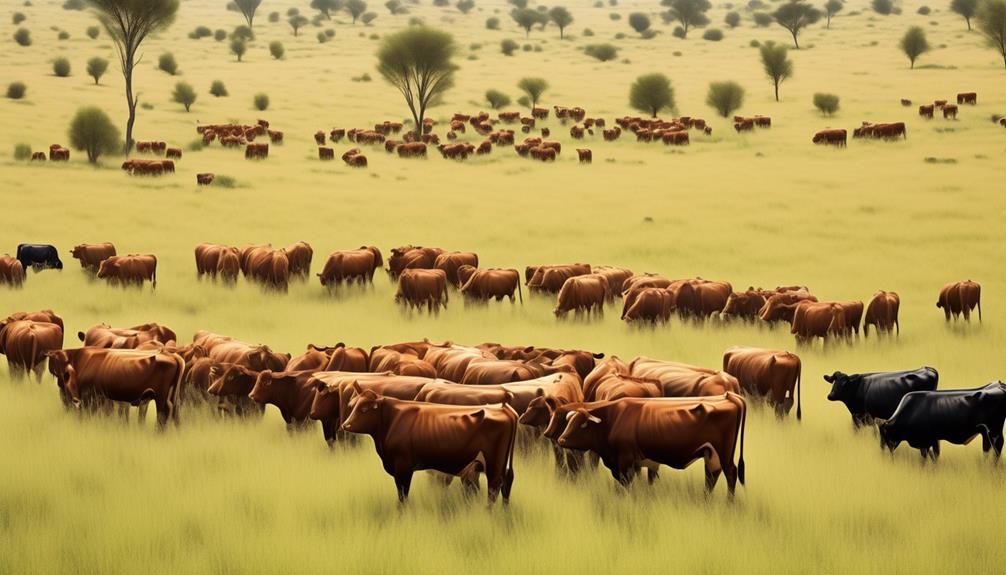
By incorporating native grass species into your cattle foraging practices, you can enhance the nutritional value of their diet while promoting a more sustainable and ecologically balanced grazing system. Native grass species offer significant biodiversity benefits and conservation advantages. They support a wide range of insects, birds, and mammals, contributing to the overall health and diversity of the ecosystem. By integrating these species into your grazing practices, you actively participate in preserving and promoting the natural diversity of your environment.
Moreover, native grass species possess inherent traits that can greatly benefit your cattle's resilience to environmental challenges. They exhibit remarkable drought resilience, enabling them to thrive in harsh conditions where other grasses may struggle. By incorporating these resilient species into your grazing lands, you provide your cattle with a more reliable food source even in times of water scarcity.
Additionally, these native grasses often demonstrate natural pest resistance, reducing the need for chemical interventions to control unwanted insects. This not only benefits the overall ecosystem by minimizing chemical exposure but also contributes to cost savings and reduced environmental impact for your cattle management practices.
Ideal Native Grass Species for Cattle
If you want to optimize your cattle foraging practices, considering the nutritional benefits and ecological advantages of native grass species, it's essential to identify the ideal options for sustaining your cattle's diet and the surrounding ecosystem.
When it comes to grazing behavior and forage preference, certain native grass species stand out as particularly beneficial for cattle. Switchgrass, for example, is a popular choice due to its high tolerance to grazing and its ability to provide ample forage throughout the grazing season. Its deep root system also aids in preventing soil erosion, making it an environmentally sound option.
Big bluestem is another excellent native grass species for cattle. Its high palatability and nutritional value make it a preferred forage choice for many cattle, and its extensive root system helps improve soil structure and moisture retention.
Indiangrass is known for its adaptability to different soil types and its high energy content, making it a valuable addition to a cattle forage diet.
Additionally, little bluestem is a native grass species that's highly resilient to drought conditions, making it an ideal choice for regions prone to dry spells.
Understanding the grazing behavior and forage preferences of your cattle can help in selecting the most suitable native grass species to enhance their foraging experience and overall well-being.
Grazing Management With Native Grasses
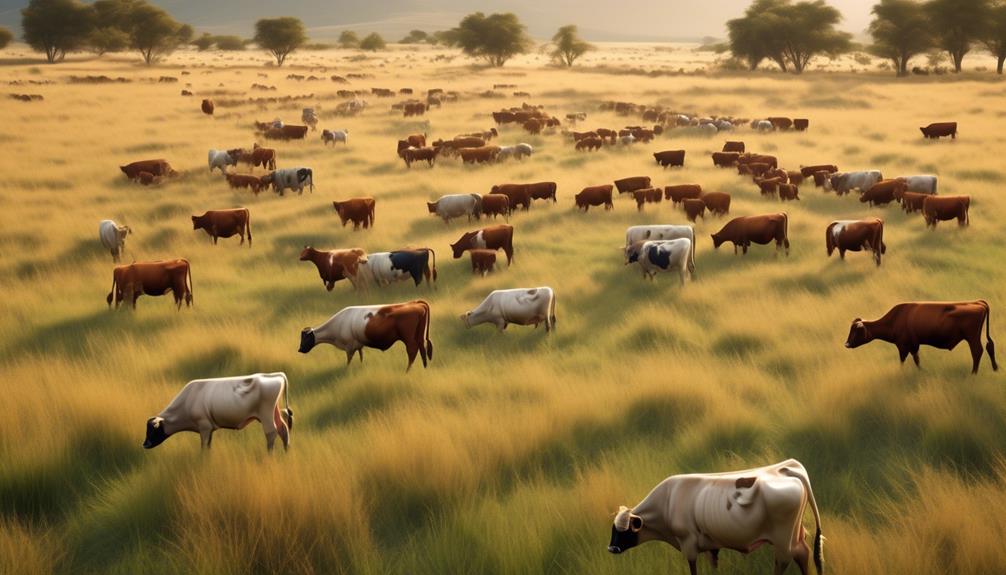
Considering the nutritional benefits and ecological advantages of native grass species, implementing effective grazing management with these grasses is essential for optimizing your cattle foraging practices. Sustainable grazing practices are crucial for maintaining the health of native grasslands and ensuring the long-term productivity of your pastures. By managing grazing in a sustainable manner, you can prevent overgrazing, promote healthy regrowth of native grass species, and maintain the overall ecological balance of your grazing lands.
One key aspect of sustainable grazing management with native grasses is rotational grazing. This method involves dividing your pasture into several smaller paddocks and rotating the cattle through these paddocks at regular intervals. This allows the grass in each paddock to recover while the cattle graze in another area, promoting healthier and more sustainable regrowth of the native grass species. Rotational grazing also helps to prevent soil erosion and allows for more effective distribution of manure, contributing to the overall health of the pasture ecosystem.
In addition to sustainable grazing practices, promoting biodiversity within your grazing lands is essential for maintaining a healthy and resilient ecosystem. Native grass species play a crucial role in supporting biodiversity by providing habitat and food sources for various wildlife species. By managing your grazing practices to support the growth and diversity of native grasses, you can contribute to the overall health and sustainability of your grazing lands.
Incorporating sustainable grazing management practices with native grass species not only benefits your cattle's foraging opportunities but also contributes to the long-term health and productivity of your grazing lands.
Nutritional Value of Native Grasses
Exploring the nutritional value of native grasses can provide valuable insights into optimizing your cattle's foraging practices. Understanding the nutritional content of these grass species is crucial for enhancing your cattle's foraging behavior and digestive efficiency. Native grasses often offer a more diverse array of nutrients compared to introduced forage species, making them an excellent choice for supporting your cattle's health and performance.
Native grasses typically have a higher fiber content, which can contribute to improved foraging behavior in cattle. The long, fibrous nature of these grasses encourages more natural grazing patterns, promoting dental health and reducing the risk of digestive issues. Additionally, the higher fiber content can enhance rumen function, leading to better digestive efficiency and nutrient utilization. This is essential for ensuring that your cattle are obtaining the necessary nutrients from their forage, ultimately impacting their overall health and productivity.
In addition to fiber, native grasses often boast a balanced nutritional profile, offering an ideal combination of protein, minerals, and energy sources. This can support your cattle's growth, reproduction, and immune function. By incorporating native grass species into your cattle's foraging areas, you can provide them with a more complete and natural diet, potentially reducing the need for supplementary feeds.
Establishing Native Grass Pastures
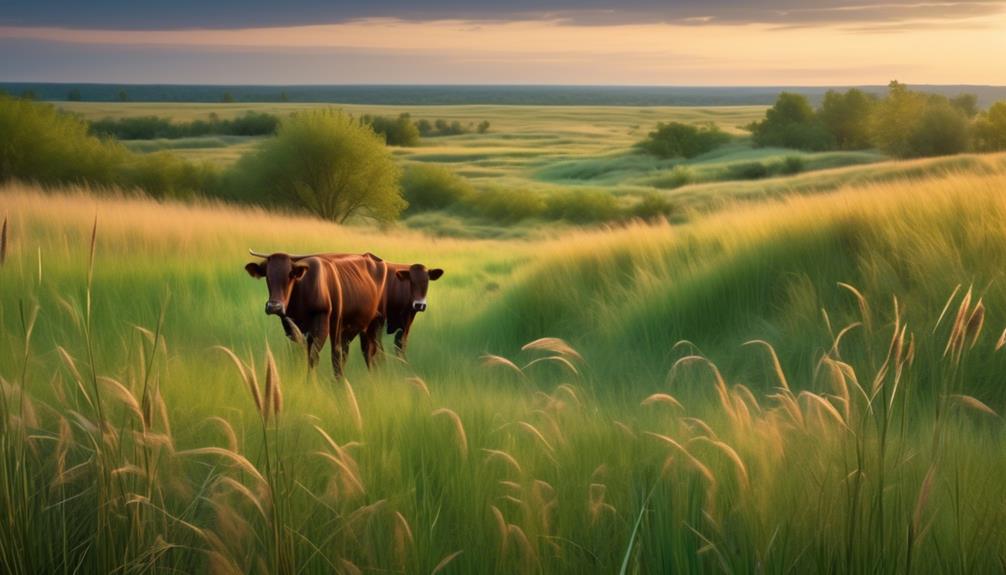
When establishing native grass pastures, prioritize selecting grass species that are well-adapted to your local climate and soil conditions for optimal forage production. Start by conducting a soil test to determine the soil's pH, nutrient levels, and texture. This will guide soil preparation methods, such as adding organic matter or adjusting pH levels, to create a favorable environment for native grasses.
When seeding, consider using a mix of native grass species to enhance biodiversity and provide a variety of forage options for cattle. Pay attention to seeding depths and techniques, as they can significantly impact establishment success.
Water management is crucial for the establishment of native grass pastures, especially in areas prone to drought. Consider implementing water-efficient irrigation systems or conservation practices to ensure adequate moisture for grass establishment. Selecting grass species with drought tolerance can also contribute to the resilience of your pasture during dry periods.
Additionally, proper grazing management can help conserve soil moisture and promote the establishment of native grasses.
Native Grasses for Soil Health
To maintain the soil health of your native grass pastures, it's essential to select grass species that not only provide optimal forage production but also contribute to the overall well-being of the soil. Choosing native grass species that promote soil fertility and ecological restoration is crucial for the sustainability of your grazing land. Here are key considerations for selecting native grasses that enhance soil health:
- Deep Root Systems: Look for native grass species with deep root systems as they help improve soil structure, reduce erosion, and enhance water infiltration. Grasses such as big bluestem and switchgrass are known for their extensive root systems, which can reach several feet into the soil, contributing to its overall health and stability.
- Nitrogen Fixation: Consider grass species like indiangrass and buffalograss that have the ability to fix nitrogen. These grasses form mutualistic relationships with nitrogen-fixing bacteria, enhancing soil fertility by converting atmospheric nitrogen into a plant-usable form, thereby reducing the need for synthetic fertilizers.
- Organic Matter Accumulation: Choose native grass species that contribute to the accumulation of organic matter in the soil. Species like prairie dropseed and sideoats grama have fine, fibrous root systems that help build soil organic matter, supporting soil structure, nutrient cycling, and overall soil health.
Seasonal Cattle Foraging Considerations
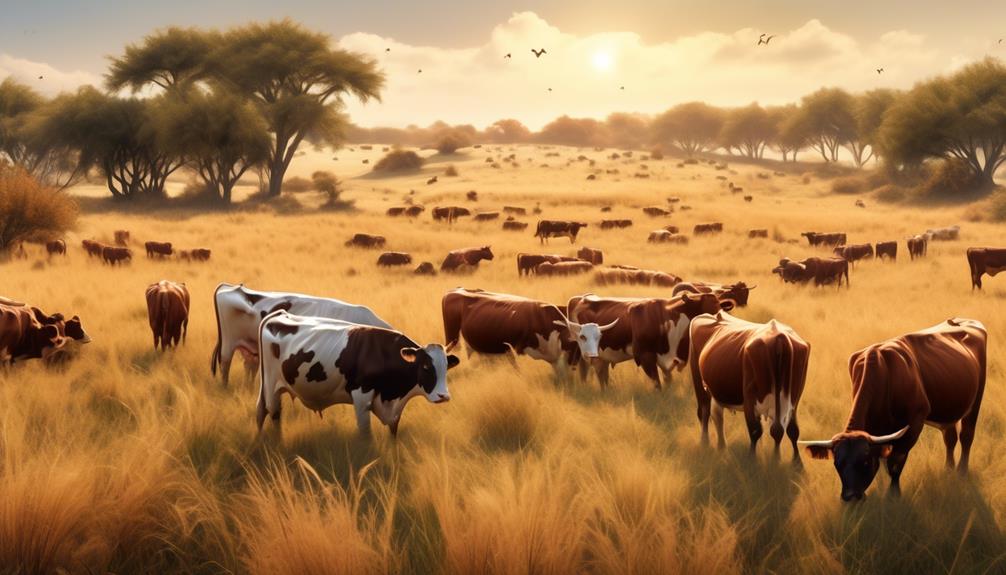
Consider adjusting your cattle foraging strategies to align with seasonal variations in pasture growth and nutritional content.
Grazing behavior and forage availability fluctuate throughout the year, impacting both the environment and animal health.
During the spring and early summer, pastures are often abundant with nutrient-rich grasses, providing an opportunity for cattle to gain weight and improve body condition. However, it's essential to monitor grazing intensity to prevent overgrazing and minimize the environmental impact during this period of rapid forage growth.
As the summer progresses into the drier months, forage availability may decline, leading to potential nutritional deficiencies for cattle. Implementing rotational grazing and supplementing with stored forages or nutritional blocks can help maintain animal health and ensure adequate nutrition during this time. Additionally, considering the use of drought-resistant native grass species can contribute to sustainable forage availability during periods of limited rainfall.
Transitioning into the fall and winter, pasture growth slows down, and the nutritional content of forage may decrease. It's crucial to adjust cattle stocking rates and grazing areas to prevent overgrazing and soil degradation. Providing access to high-quality forage or supplementary feed can help support cattle through the winter months and maintain their overall health and productivity.
Economic Impact of Native Grass Integration
Integrating native grasses into your cattle foraging strategies can have a significant impact on your bottom line. By incorporating native grass species into your cattle's diet, you not only enhance their health and productivity but also contribute to cost savings and potential revenue streams.
Consider the economic analysis and market demand when evaluating the impact of native grass integration:
- Reduced Feed Costs: Native grasses are often more resilient and require minimal maintenance compared to traditional forage crops. This can result in lower feed costs as your cattle can rely more on naturally occurring grasses, reducing the need for expensive supplemental feed.
- Improved Cattle Performance: Conduct an economic analysis to assess the impact of native grass integration on your cattle's overall performance. Healthier and well-nourished cattle can lead to improved weight gain and reduced healthcare expenses, positively influencing your economic outcomes.
- Market Demand and Premium Pricing: As consumer preferences shift towards sustainably and ethically sourced products, there's a growing market demand for grass-fed and pasture-raised beef. By integrating native grasses into your foraging strategies, you can position your cattle products to meet this demand, potentially commanding premium pricing in the market.
Considering the economic benefits of native grass integration and aligning your strategies with market demands can't only enhance your operational efficiency but also open up new avenues for increased profitability in the cattle industry.
Frequently Asked Questions
Can Native Grass Species Improve the Overall Health and Well-Being of Cattle?
You can improve cattle health and well-being by incorporating native grass species into their diet. These grasses enhance nutrition and promote natural grazing behavior, ultimately leading to better overall health and well-being for the cattle.
How Do Native Grass Species Contribute to Reducing the Environmental Impact of Cattle Grazing?
To reduce the environmental impact of cattle grazing, native grass species contribute to environmental sustainability and grazing efficiency. They provide nutritious forage, reduce soil erosion, and enhance biodiversity, making cattle grazing more sustainable in the long run.
Are There Any Potential Challenges or Limitations in Incorporating Native Grass Species Into Cattle Foraging Practices?
Incorporating native grass species into cattle foraging practices may pose challenges and limitations. These can impact the ecological balance, soil health, and overall effectiveness. Careful planning and management are crucial to address these potential issues.
What Are Some Specific Examples of Successful Integration of Native Grass Species Into Cattle Grazing Operations?
You've successfully integrated native grass species into cattle grazing operations by implementing improved forage and grazing efficiency strategies. By focusing on grassland management, you've achieved a more sustainable and productive foraging environment for your cattle.
How Do Native Grass Species Compare to Traditional Forage Options in Terms of Cost-Effectiveness for Cattle Producers?
When it comes to cost comparison, native grass species offer significant potential for cost-effectiveness compared to traditional forage options. Additionally, they provide nutritional benefits that can improve the overall health and productivity of your cattle.
Conclusion
In conclusion, enhancing cattle foraging with native grass species can provide numerous benefits for both the cattle and the environment.
By incorporating ideal native grass species, practicing proper grazing management, and considering seasonal foraging considerations, you can improve the nutritional value of the cattle's diet, promote soil health, and potentially have a positive economic impact.
Consider integrating native grasses into your cattle foraging practices to see these benefits firsthand.
